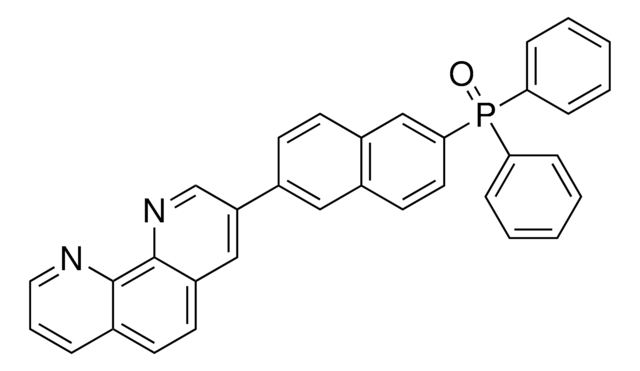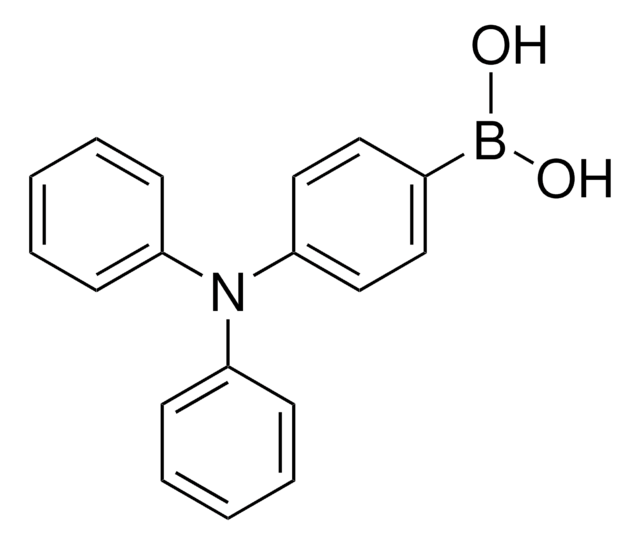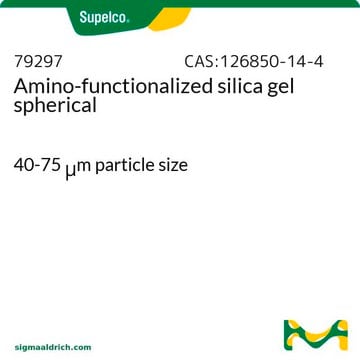推荐产品
描述
Band gap in film: 2.99eV, calculated from UV-vis
Band gap in solution: 3.00eV, calculated from UV-vis
化驗
≥99% (HPLC)
形狀
powder
溶解度
insoluble (Methanol and Hexane)
soluble (DMSO, THF, Toluene, o-Xylene, Anisole, Chloroform, Chlorobenzene, and 1,2-Dichlorobenzene)
軌道能量
HOMO - 4.85 eV
SMILES 字串
CCC(CCCC)CN1C2=CC(N(C3=CC=C(OC)C=C3)C4=CC=C(OC)C=C4)=CC=C2C5=CC=C(N(C6=CC=C(OC)C=C6)C7=CC=C(OC)C=C7)C=C15
一般說明
EH44 is a carbazole derivative used as interfacial, hole transporting and contact layer in perovskite solar cell (PSC). Using EH44 can increase the performance and the lifetime of the devices. EH44 is a Li+ free, hydrophobic hole transporting material (HTM) which can eliminate degradation due to Li+ migration, supresse degradation due to moisture absorption and has long-term stability in fabricated PSC.
應用
EH44 can be used as an HTM with a high power conversion efficiency (PCE) in comparison to PCE of spiro-OMETAD. It was used in PSC with 94% retention of peak efficiency after 1000 hours of operation.
EH44 is a Li+ free, hydrophobic hole transporting material (HTM). It eliminates degradation due to Li+ migration, supresses degradation due to moisture absorption and thus showed promise for achieving long-term stability in fabricated perovskite solar cells.
Using EH44 as HTM in a device configuration of: SnO2/PAL/EH44/MoOx /Al, not only generated high power conversion efficiency (PCE) comparable to the record PCE by using the state-of-the-art-HTM Spiro-OMeTAD, but also most importantly showed greatly improved device stability: even under the combined stresses of light (including ultraviolet light), oxygen and moisture, perovskite solar cells using EH44 as hole transporting layer were shown to retain 94% of their peak efficiency despite 1,000 hours of continuous unencapsulated operation in ambient air conditions (relative humidity of 10-20%). When stability tests were conducted in an inert atmosphere, degradation of only ∼2% over the course of 1,500 hours of continuous operation was observed.
Note that in the above mentioned result, silver bis(trifluoromethanesulfonyl)imide (product 668001) was used to oxidize EH44 and yield EH44+TFSI−.EH44+TFSI− was then blended with neat EH44 at various ratios to control the conductivity (and optical transparency if desired) and optimize the device performance. The impressive power conversion efficiency (PCE) of 18.5% was achieved for a perovskite solar cell using EH44 layers of ∼60 nm thickness doped with 14wt% EH44+TFSI− and 25 mg/ml 4-tert-butylpyridine (product 142379), which is comparable to device performance using spiro-OMeTAD (19%) as the HTM.
Using EH44 as HTM in a device configuration of: SnO2/PAL/EH44/MoOx /Al, not only generated high power conversion efficiency (PCE) comparable to the record PCE by using the state-of-the-art-HTM Spiro-OMeTAD, but also most importantly showed greatly improved device stability: even under the combined stresses of light (including ultraviolet light), oxygen and moisture, perovskite solar cells using EH44 as hole transporting layer were shown to retain 94% of their peak efficiency despite 1,000 hours of continuous unencapsulated operation in ambient air conditions (relative humidity of 10-20%). When stability tests were conducted in an inert atmosphere, degradation of only ∼2% over the course of 1,500 hours of continuous operation was observed.
Note that in the above mentioned result, silver bis(trifluoromethanesulfonyl)imide (product 668001) was used to oxidize EH44 and yield EH44+TFSI−.EH44+TFSI− was then blended with neat EH44 at various ratios to control the conductivity (and optical transparency if desired) and optimize the device performance. The impressive power conversion efficiency (PCE) of 18.5% was achieved for a perovskite solar cell using EH44 layers of ∼60 nm thickness doped with 14wt% EH44+TFSI− and 25 mg/ml 4-tert-butylpyridine (product 142379), which is comparable to device performance using spiro-OMeTAD (19%) as the HTM.
儲存類別代碼
11 - Combustible Solids
水污染物質分類(WGK)
WGK 3
閃點(°F)
Not applicable
閃點(°C)
Not applicable
其他客户在看
Recent Progress in Inorganic Hole Transport Materials for Efficient and Stable Perovskite Solar Cells
Gil B, et al.
Electronic Materials Letters, 4(2), 1-20 (2019)
Thermally stable perovskite solar cells by systematic molecular design of the hole-transport layer
Schloemer TH, et al.
ACS Energy Letters, 4(2), 473-482 (2019)
Tomas Leijtens et al.
ACS applied materials & interfaces, 8(9), 5981-5989 (2016-02-10)
Solar cells based on organic-inorganic perovskite semiconductor materials have recently made rapid improvements in performance, with the best cells performing at over 20% efficiency. With such rapid progress, questions such as cost and solar cell stability are becoming increasingly important
Stability at Scale: Challenges of Module Interconnects for Perovskite Photovoltaics
Christians J A, et al.
ACS Energy Letters, 3(10), 2502-2503 (2018)
Tailored interfaces of unencapsulated perovskite solar cells for >1,000 hour operational stability
Christians J A, et al.
Nature Energy, 3(1), 68-74 (2018)
商品
Professor Chen (Nankai University, China) and his team explain the strategies behind their recent record-breaking organic solar cells, reaching a power conversion efficiency of 17.3%.
我们的科学家团队拥有各种研究领域经验,包括生命科学、材料科学、化学合成、色谱、分析及许多其他领域.
联系技术服务部门










